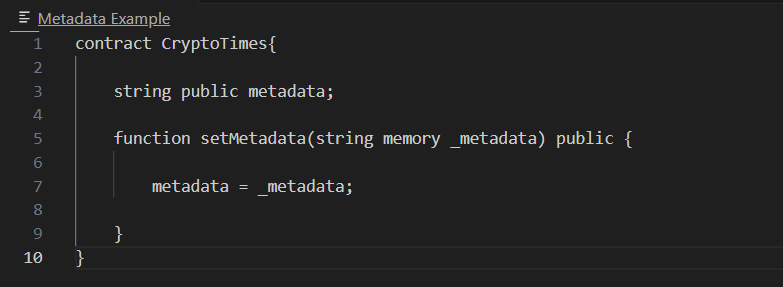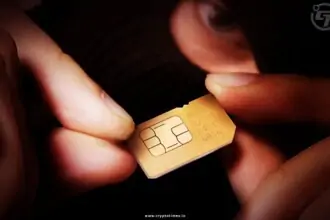The dynamic realm of blockchain is continually expanding and tons of newer applications are introduced on top of it regularly. As the adoption of blockchain technology is going through a major paradigm shift, its utility is extending beyond just transferring cryptocurrency assets from one address to another.
Blockchain provides magnificent data storing facilities with numerous functionalities and metadata is one of them. This feature has an important role in enhancing adaptability, efficiency, and accessory for blockchain transactions.
What is Metadata in Blockchain?
Metadata is the additional information attached to blockchain transactions. It contains comprehensive details of a transaction such as timestamp, sender/receiver, gas fee, or any textual content. As the transactions on the blockchain are irreversible, the metadata is added to give it context for references.
While the primary function of a blockchain is to perform transactions, metadata enables those transactions to have an identity or referential sub-content. This feature essentially improves the functionality further than just the transfer of crypto assets.
Metadata could be also described as “Data for Data” as it provides extra details regarding the data or assets being transferred.
Types of Metadata
Metadata is mainly of two types:
1. On-chain Metadata
On-chain metadata is directly stored on the blockchain as a part of transactions. It includes information such as transaction labels, remarks, and references or links to other contracts. This information can be seen and accessed by anyone as it is stored on the blockchain.
2. Off-chain Metadata
Off-chain metadata is added to the transaction but it is not directly stored on the blockchain. Such data is mentioned in the transaction via links or outgoing references, leading to other documents, filings, or sources available on the Internet.
While on-chain metadata is included in the blockspace, off-chain metadata remains non-subjective to the transaction processing hence it is used in need of elaborative metadata.
How Metadata Is Stored On Blockchain
Most of the on-chain metadata is associated with transactions such as transaction properties and smart contract code. This data is an integral part of the blockchain’s data structure, and it is permanently stored across all the copies of the blockchain that nodes download.
All blockchain transactions have some elementary metadata, which contains basic details such as sender and receiver address, transferred asset amount, and timestamp. Like transactions, the smart contract code and its associated data, including functions and variables, are also stored as on-chain metadata in the blockchain.
All these on-chain data are accessible through blocks for verification, which can be found via block headers. On the other hand, off-chain metadata is not primarily stored on the blockchain.
The intent behind doing so is that sometimes metadata consists of larger files or content that may increase the size of a transaction. This kind of metadata is stored on external storage sources like IPFS, which provides an ideal decentralized data storage option.
How to Add Metadata in Blockchain Transactions
Metadata is added to blockchain transactions using smart contracts. Besides elementary metadata, which is automatically generated while the transaction is executed, external metadata can be added using this method.
Although it requires users to have some coding experience as it needs to be inserted within the smart contract code. To do so, a smart contract first needs to be created. Below is a Solidity smart contract code block that shows how metadata is added manually.

In the example, adding metadata involves creating a string variable inside the contract. We have created a smart contract, CryptoTimes, and defined a variable using string data type. String variables can be assigned with any value in text format, including numbers, messages, links, etc.
The user will need to provide metadata as input when this contract is executed. Before sending the transaction, the sender will have to communicate with this contract. It can be done by using existing libraries such as web3.js and ethers.js.
Some Ethereum wallet also allows adding metadata while sending transactions which does not require such coding.
Uses of Blockchain Metadata
Blockchain metadata can be used for a wide range of applications. Every project using blockchain in its infrastructure can benefit from Metadata. Below are the applications where blockchain metadata can be used;
1. NFTs
The application of non-fungible tokens (NFTs) is one of the most beneficial with Metadata as it stores the creator’s name, previous owners, characteristics, and more. All this information is critical for any digital collectibles or NFTs.
2. Digital Assets
Several digital assets deployed on blockchain contain unique details stored using Metadata. It can help authenticate a crypto asset while also enabling it to have specified values.
3. Smart Contracts
Metadata is one of the most important elements of a smart contract. As these contracts are self-executing, Metadata can provide conditional information to enforce the transactions on the blockchain.
4. Supply Chain
The blockchain-based supply chain ecosystem can utilize Metadata to improve product traceability and transparency. It can also provide details on product authenticity and additional details about goods or services.
5. Data Records
Metadata enables efficient data recording and managing processes as it could add labels to data records. This allows simplified data access as metadata properties allow one to sort or find specific records from large data structures.
6. Digital identity
Metadata can also be used in digital identity management as it makes it possible to enter personalized credentials and information for user directories. Groups, organizations, or even governments can benefit from this application while inheriting the security of blockchain technology.
Also Read : Real-World Use Cases of Blockchain Technology
Conclusion:
While metadata enables additional functionality, it also needs to be noted that metadata requires block space to be stored on the blockchain. The higher the size of metadata, the more space it needs. It could also require more gas fees associated with the transaction as the size of the transaction will also increase.
In the coming time, blockchain metadata could potentially become an essential functionality as this technology is rapidly shifting toward retail applications. It can also become an epicenter for developing newer applications that inherit immutability, security, and several other maneuvering characteristics of blockchain technology.
FAQs
Q1. What are on-chain and off-chain metadata in blockchain?
Ans. Onchain metadata refers to the elementary data, such as transaction sender/receiver details and timestamps, while offchain metadata includes links or references to external information.
Q2. Can blockchain metadata be deleted?
Ans. Blockchain metadata can not be deleted as it is stored on the blockchain. The blockchain’s features of immutability and irreversibility do not allow the deletion of metadata.
Q3. How metadata is added to blockchain transactions?
Ans. Metadata is inserted in the transaction using a smart contract, and it is permanently stored on the blockchain after the transaction is broadcast.







